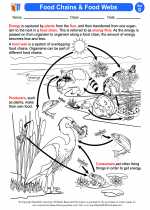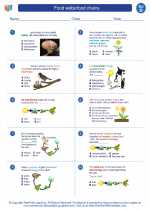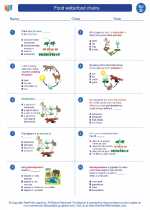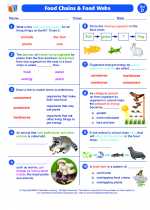Food webs/food chains -> ecological succession
Ecological Succession
Ecological succession is the gradual process by which ecosystems change and develop over time. It is the observed process of change in the species structure of an ecological community over time.
Types of Ecological Succession
Primary Succession: This type of succession occurs in an area that is completely barren, such as a newly formed volcanic island or a glacial moraine. It starts with the colonization of barren land by pioneer species such as lichens and mosses, and progresses through a series of stages until a climax community is established.
Secondary Succession: This type of succession occurs in an area where an existing community has been partially or completely destroyed, such as after a fire or human disturbance. It begins with the reestablishment of vegetation in the area and follows a similar pattern to primary succession, ultimately leading to the development of a climax community.
Stages of Ecological Succession
Pioneer Stage: This stage involves the colonization of the area by hardy and adaptable species such as lichens and mosses. These species can survive in harsh conditions and begin to break down the rock and soil, preparing the area for other plant species.
Intermediate Stage: As the pioneer species die and decompose, they contribute organic matter to the soil, making it more fertile. This allows other plant species, such as grasses and shrubs, to establish themselves in the area.
Climax Community: Eventually, the community reaches a stable and balanced state known as the climax community, which consists of a diverse range of plant and animal species well adapted to the prevailing environmental conditions. This community is relatively stable and can persist for an extended period if not disturbed.
Importance of Ecological Succession
Ecological succession plays a crucial role in the development and maintenance of ecosystems. It leads to the formation of diverse and stable communities that can provide habitats for a wide variety of species. Additionally, it contributes to the renewal of soil fertility and the regulation of various ecosystem processes, such as nutrient cycling and water retention.
Study Guide
Here are some key points to remember about ecological succession:
- Ecological succession is the gradual process of change in the species structure of an ecological community over time.
- There are two main types of ecological succession: primary succession and secondary succession.
- The stages of ecological succession include the pioneer stage, intermediate stage, and climax community.
- Ecological succession is important for the development and maintenance of diverse and stable ecosystems.
[Ecological Succession] Related Worksheets and Study Guides:
.◂Science Worksheets and Study Guides Fourth Grade. Food webs/food chains

 Activity Lesson
Activity Lesson
 Worksheet/Answer key
Worksheet/Answer key
 Worksheet/Answer key
Worksheet/Answer key
 Worksheet/Answer key
Worksheet/Answer key
 Worksheet/Answer key
Worksheet/Answer key
 Vocabulary/Answer key
Vocabulary/Answer key
 Vocabulary/Answer key
Vocabulary/Answer key
 Vocabulary/Answer key
Vocabulary/Answer key
